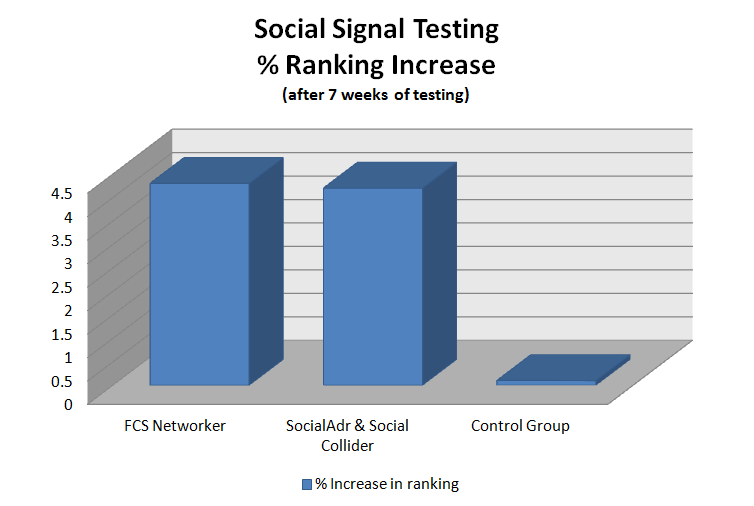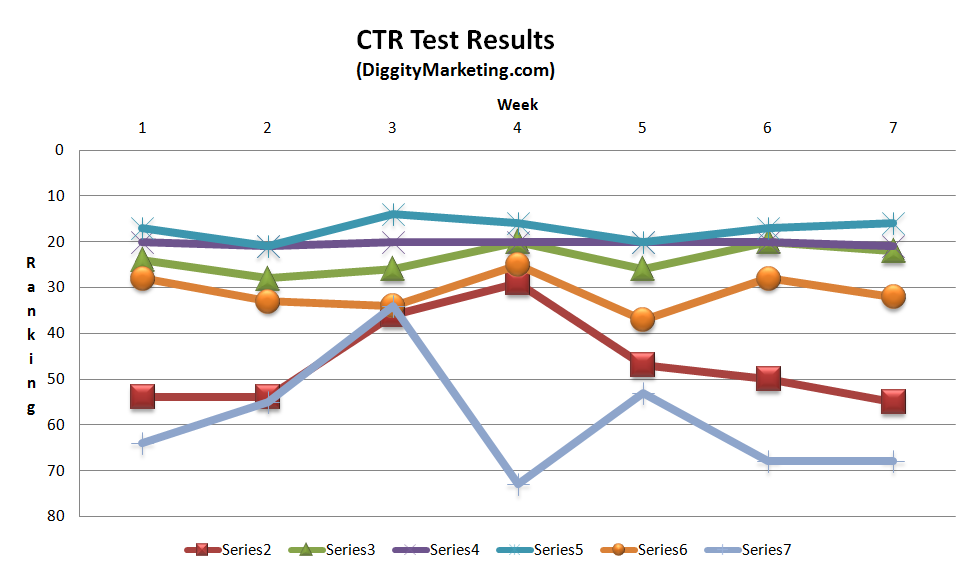There’s a ton of buzz going around about what the next face of SEO is going to look like. Those who stay ahead of the curve are going to reap the benefits. In case you’re not up to speed, here’s a summary on a few SEO techniques are being hyped up right now and my testing results on each.
Testing Results: Social Signals
Tweets, Shares, G+’s, Facebook likes, Pins, and bookmarks.
There’s been a ton of talk about social signals over the past 3 months. People have come forth saying that they’re ranking local search YouTube videos solely on social signals. The main debate seems to be over how the social signals are obtained. Namely, if they should come from real accounts or automatically generated accounts.
Here’s the test scenario I setup, comparing three different groups:
- FCS Networker – Auto-generates accounts on many social bookmarking platforms and Twitter; and posts to them. No limit on the # of accounts created. (5 testcases)
- SocialAdr + Link Collider – Uses a credit system to encourage people to post on each other’s real accounts (with the option to simply buy credits). SocialAdr focuses around bookmarks, while Link Collider provides signals from G+, FB, Twitter, Pinterest, etc. (5 testcases)
- Control Group – No social signals. (3 testcases)
Signals were sent to sets A & B on week 2 and were dripped over the course of 6 additional weeks. All sites had zero social signals before the test began. Each site received the same amount of signals.
Results:
- Negligible difference between approach A and B – Whether or not social signals are coming from brand new auto-generated accounts or old accounts, G doesn’t seem to notice. I’ve confirmed this with many others, including an actual developer of a social signal service similar to Approach B. As of now, it seems a signal is just a signal. I actually expected a better result from B because it includes more “important” social platforms (FB, G+) than A. B did however achieve a faster ranking increase, most likely because their accounts are already indexed and ready to be crawled.
- Groups A and B showed a slight positive increase (3.6-3.7%) in result compared to the control group C.
Summary:
Moz recently said that they believe social signals only contribute to a total ranking factor of 5%. I agree.
In low competition niches, this 5% can make a big difference because it’s you against other sites with zero SEO. Anything you do will yield a positive result.
In high competition niches, my analysis shows me that that social signals will give you a boost, but more importantly, social signals are absolutely needed to justify the backlinks you’re getting. A site with 20 high authority backlinks and zero social signals simply doesn’t make sense to Google, and it shouldn’t. This is further backed up by some real money sites of mine that have died with no social signals, while others survived in the same niche that had social signals. If you’re in a remotely competitive niche, then you need social.
Recommendation:
At this point in time, FCS Networker (click for best price) is my recommendation. It’s cheap ($27/month), completely automated, and you can run it on an unlimited number of domains and send an unlimited amount of signals. The smallest package for SocialAdr and Link Collider togeter about $30/month but only supports 1-2 URLs with minimal amounts of shares. Since they both yield the same result, I’d rather go with FCS which is cheaper, easier to use, and scalable.
Will FCS be a solution for years to come? Probably not. As we’ve seen with backlinks, the quality control noose will tighten and eventually we’ll need aged accounts with followers/fans and non-spun content. But that’s not going to happen anytime soon.
Click-Through Rate (CTR)
For years now, CTR is has been known to be a ranking factor in Google’s algorithm. When a search is made, the sites that are clicked on the most often (i.e. have the highest CTR) are deemed to be more relevant, and a ranking boost is theoretically applied.
I tested CTR with a upcoming service that outsources individual users across the US (and other countries). Software is installed on their computers to ensure they make a search, find your site, spend time on your page, and randomly browse on other pages (reducing bounce rate).
Results:
I have to say I was pretty excited for this to work out. The logic behind it makes sense and the solution’s implementation seems sound. Over 6 testcases spread out over brand, EMD, aged, non-aged, competitive national searches, and local low competition searches… the results were flat.
That being said, I’ve talked with others in my circle of SEO’s and people are reporting positive results only if their original rank was on the first page already. In all fairness, my testcases all had page 2-7 ranks. I’ll get back to you later with my tests on first page rankers.
Summary:
Right now, I won’t recommend this because I personally haven’t seen a positive result so far. There’s potential safety issues, especially if G catches onto the IPs of the searchers. However, climbing 1-3 spots on the first page for a minimal price, while being completely automated, is a no brainer. I’m waiting to see it for myself though.
PBN Sites Are Still Killing It
With all the testing I’ve been doing, I’m still finding that the main tool in your SEO arsenal remains to be PBNs. There simply doesn’t exist a more effective, faster way to rank a site. Here’s just a couple examples of it kicking ass just a few weeks ago (both results are from a single PBN link pointing to a real, customer money site).





I would like to say thank you for taking the time and doing this case study. It saves me many hours of testing and trying to figure this out. I had always wondered if CTR had any affect on rankings.
No problem.
Nice case study! It would have never crossed my mind that ctr signals could be a ranking factor. Although you prove that they don’t really do anything at least i know now i don’t have to have to include it in my ranking strategy.
Well the theory makes sense. Google should want to rank sites higher that people are clicking on. However, I don’t think CTR should be getting all the hype that its getting lately. CTR boils down to who has the best TITLE and DESCRIPTION metas… hardly an indication of site quality.
Been looking all over the place to find out if Social Signals do actual help or not. Do you think that if the social signals where more niche specific they would help ?
Hi Marko,
I doubt it because social profiles are usually tied to people personal accounts. Twitter, Facebook etc… these are all real people and not niche-specific entities. Sure, a Facebook profile might have “interests” in specific niche related categories, but I highly doubt Google has access to this. At least right now they don’t.
Best,
Matt
I have the same opinion as you Matt. Maybe in some years Google develops an algorithm that detects and understands the interests of each profile but that is not the case right now.
Nice case study.
As well as the money site do you also send social signals to the PBN links?
That’s correct, Craig. However I haven’t quantified the benefit of doing so. That’s for the next case study coming next month or so. 🙂
So Matt, looking at your tests, you are actually saying you see benefist of pbn almost imeddiatelly. So you don’t believe in 3 weeks or a month google dance, sandbox, etc…
Question from this: if I put a pbn link on my let’s assume solid site, I should see results within a week?
Matija, Slovenia
Pretty much all my PBNs show a result in a maximum of 10 days. But then again, I’m not using expired domains.
Hey Matt,
Very appreciate for your blog and case studies, they helped me a lot.
I have one question:
When you mean not expired, you talk about those you catch that are still indexed, but not necessarily hosted for a while (like year or so)? That will mean they still have age factor, am I right?
Thanks
Michal
I don’t pick up domains that have a drop history.
Having 3/4 company social accounts and linking back to my company website is the social linking I am currently doing. Is this what you mean in the article? or are you talking about creating multiple user accounts on social and linking back to money (company) site?
3rd party social signals that appear to be coming from 3rd parties.
Hey Matt,
Awesome post like always. Question: Do you use FCS Networker solely for Social Signals? I’m going through their tutorial videos and it looks like you can do a lot more than just send social signals. Just wondering if things like link wheels & pyramids are necessary. It would be awesome if you could go into more detail of the features you use in FCS… Thanks in advance!
I used to use them for trust tiering.
These days I don’t bother with tiered link building anymore.
Hi Matt!
Could you elaborate on why you stopped tiered link building? Is it just not worth the effort having the PBN you have and you would still do it if you were starting all over again or… You think it isn’t valuable anymore at any stage?
Thanks for the great work on your blog and sharing. I discovered it recently and I just can’t stop reading it!
Cheers!
I think tiered link building definitely has its place, but PBNs are working so well right now there really isn’t any need to deviate.
Great to hear. Thanks for answering!
Let’s say you are doing reputation management, could you use that service to have people click all the good websites except the negative one, would the negative one eventually fall from the first page?
Also what is the company called that outsources people to click websites.
Pogo-sticking works, but its hard to pull off. Remember, Google makes PPC money off clicks so they’re pretty darn good at not being fooled.
Comments are closed.